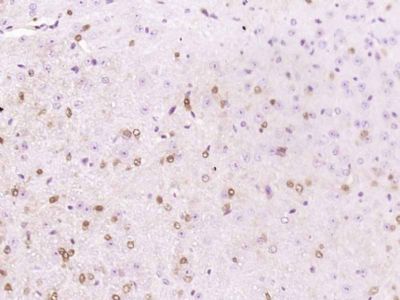APBA1 Polyclonal Antibody
Purified Rabbit Polyclonal Antibody (Pab)
- SPECIFICATION
- CITATIONS
- PROTOCOLS
- BACKGROUND

Application
| WB, IHC-P, IHC-F, IF, ICC, E |
|---|---|
| Primary Accession | Q02410 |
| Reactivity | Rat, Pig, Dog, Bovine |
| Host | Rabbit |
| Clonality | Polyclonal |
| Calculated MW | 93 KDa |
| Physical State | Liquid |
| Immunogen | KLH conjugated synthetic peptide derived from human APBA1 |
| Epitope Specificity | 451-550/837 |
| Isotype | IgG |
| Purity | affinity purified by Protein A |
| Buffer | 0.01M TBS (pH7.4) with 1% BSA, 0.02% Proclin300 and 50% Glycerol. |
| SUBCELLULAR LOCATION | Nucleus. |
| SIMILARITY | Contains 2 PDZ (DHR) domains. Contains 1 PID domain. |
| SUBUNIT | Part of a multimeric complex containing Munc18-1 and syntaxin-1. Also part of the brain-specific heterotrimeric complex LIN-10/X11-alpha, LIN-2/CASK, and LIN7. Binds to the cytoplasmic domain of amyloid protein (APP). Interacts (via PDZ 1 and 2 domains) with FSPB. |
| Important Note | This product as supplied is intended for research use only, not for use in human, therapeutic or diagnostic applications. |
| Background Descriptions | The Beta-Amyloid precursor protein (Beta-APP) is a major constituent of the amyloid deposits in patients with Alzheimer’s disease. The Beta-Amyloid precursor is known to interact with several proteins, including X11 and the G heterotrimetric protein APP-BP1. The neuronal, transmembrane protein X11 is known to bind to the ∫-Amyloid precursor protein via a phosphotyrosine binding (PTB) domain, reducing the secretion of cellular Beta-APP and slowing Beta-APP processing pathways. X11 binds specifically to the YENPTY motif, which is involved in the internalization of Beta-APP. Multiple splice varitents of X11 have been identified, including X11å (also designated Mint 1), X11Beta (Mint 2) and X11(Mint 3). |
| Gene ID | 320 |
|---|---|
| Other Names | Amyloid-beta A4 precursor protein-binding family A member 1, Adapter protein X11alpha, Neuron-specific X11 protein, Neuronal Munc18-1-interacting protein 1, Mint-1, APBA1, MINT1, X11 |
| Target/Specificity | Brain and spinal cord. |
| Dilution | WB=1:500-2000,IHC-P=1:100-500,IHC-F=1:100-500,ICC=1:100-500,IF=1:100-500,ELISA=1:5000-10000 |
| Format | 0.01M TBS(pH7.4), 0.09% (W/V) sodium azide and 50% Glyce |
| Storage | Store at -20 ℃ for one year. Avoid repeated freeze/thaw cycles. When reconstituted in sterile pH 7.4 0.01M PBS or diluent of antibody the antibody is stable for at least two weeks at 2-4 ℃. |
| Name | APBA1 |
|---|---|
| Synonyms | MINT1, X11 |
| Function | Putative function in synaptic vesicle exocytosis by binding to Munc18-1, an essential component of the synaptic vesicle exocytotic machinery. May modulate processing of the amyloid-beta precursor protein (APP) and hence formation of APP-beta. Component of the LIN-10- LIN-2-LIN-7 complex, which associates with the motor protein KIF17 to transport vesicles containing N-methyl-D-aspartate (NMDA) receptor subunit NR2B along microtubules (By similarity). |
| Cellular Location | Cytoplasm. Cytoplasm, perinuclear region. Nucleus. Note=Only about 5% of the protein is located in the nucleus |
| Tissue Location | Brain and spinal cord. Isoform 2 is expressed in testis and brain, but not detected in lung, liver or spleen |

Thousands of laboratories across the world have published research that depended on the performance of antibodies from Abcepta to advance their research. Check out links to articles that cite our products in major peer-reviewed journals, organized by research category.
info@abcepta.com, and receive a free "I Love Antibodies" mug.
Provided below are standard protocols that you may find useful for product applications.
If you have used an Abcepta product and would like to share how it has performed, please click on the "Submit Review" button and provide the requested information. Our staff will examine and post your review and contact you if needed.
If you have any additional inquiries please email technical services at tech@abcepta.com.













 Foundational characteristics of cancer include proliferation, angiogenesis, migration, evasion of apoptosis, and cellular immortality. Find key markers for these cellular processes and antibodies to detect them.
Foundational characteristics of cancer include proliferation, angiogenesis, migration, evasion of apoptosis, and cellular immortality. Find key markers for these cellular processes and antibodies to detect them. The SUMOplot™ Analysis Program predicts and scores sumoylation sites in your protein. SUMOylation is a post-translational modification involved in various cellular processes, such as nuclear-cytosolic transport, transcriptional regulation, apoptosis, protein stability, response to stress, and progression through the cell cycle.
The SUMOplot™ Analysis Program predicts and scores sumoylation sites in your protein. SUMOylation is a post-translational modification involved in various cellular processes, such as nuclear-cytosolic transport, transcriptional regulation, apoptosis, protein stability, response to stress, and progression through the cell cycle. The Autophagy Receptor Motif Plotter predicts and scores autophagy receptor binding sites in your protein. Identifying proteins connected to this pathway is critical to understanding the role of autophagy in physiological as well as pathological processes such as development, differentiation, neurodegenerative diseases, stress, infection, and cancer.
The Autophagy Receptor Motif Plotter predicts and scores autophagy receptor binding sites in your protein. Identifying proteins connected to this pathway is critical to understanding the role of autophagy in physiological as well as pathological processes such as development, differentiation, neurodegenerative diseases, stress, infection, and cancer.


